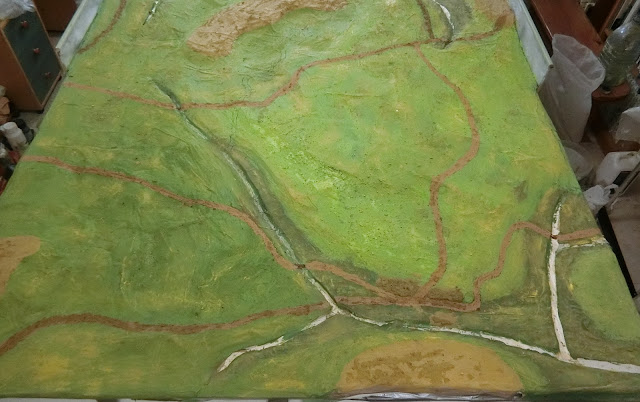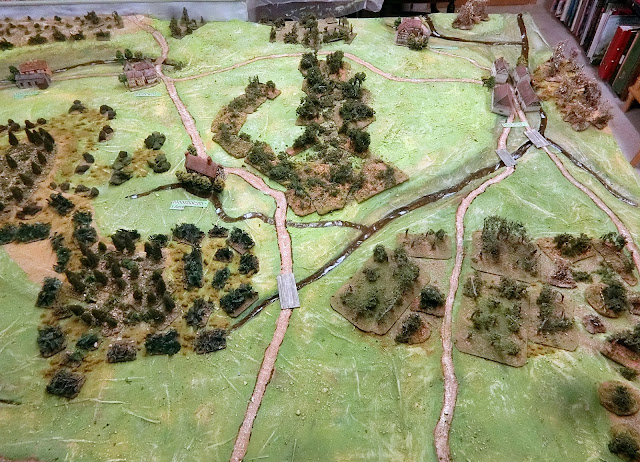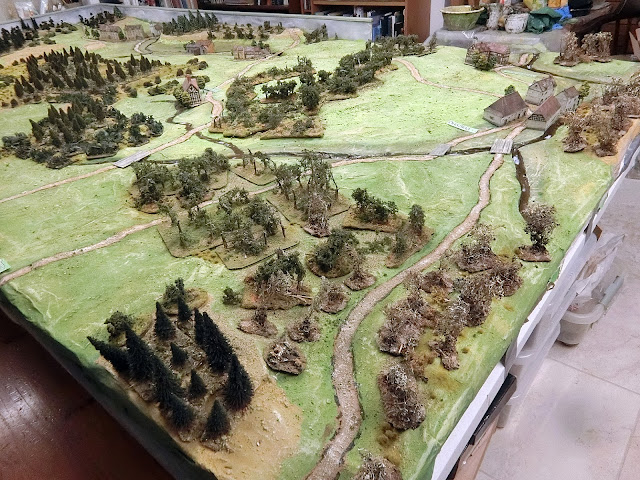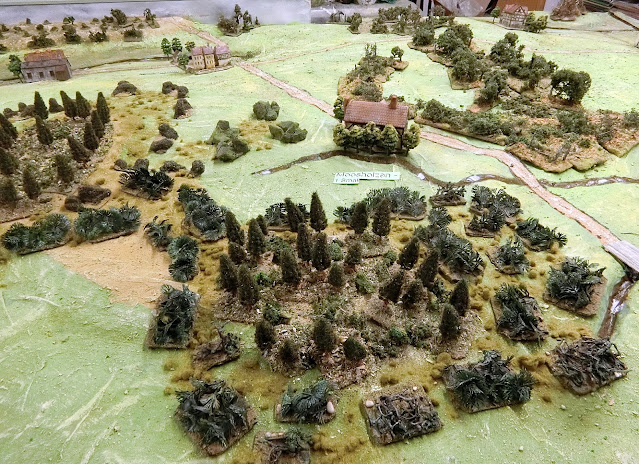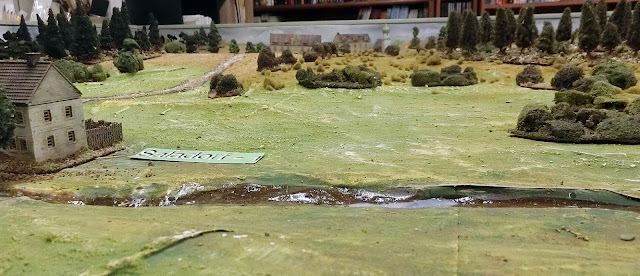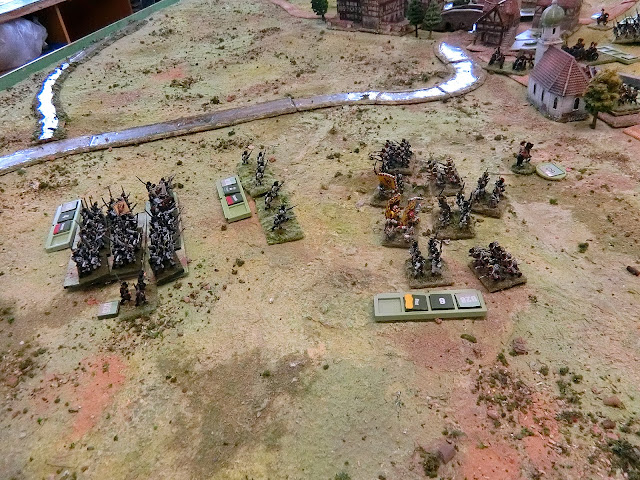Those who are following my progress with this project ( see Reviving my 1809 campaign) might think I am being slack by not posting often, but if anything, the opposite is true. It's just that I tend be striving towards the next goals such as rules updates, research into battles and orbats, designing maps and making terrain features, not to mention more troops to paint and base, rather than blogging my every step. In the previous post we saw how I'd got a workable set of rules (my expansion of Honours of War) that still needed some significant adaptations, particularly to skirmishers and artillery to make them more worthwhile. Also I had been too ambitious and the big game for only two players in a day had not tested the extended rhythm of play.
For the next one I was confident enough to start our "refighting" of some of the important engagements. Happily the first was the Austrian toehold into Bavaria proper across the Isar river at Landshut on 16th April 1809. I say happily because this was only a Division plus-sized action and would be manageable for my 1:50 "Corps sized" rules in a day. It would enable us to see how the eb and flow worked over 8-10 moves - around 3 hours historical time.
 |
| Steve Johnson and Richard Newcombe fully concentrate on the action |
 |
| John Gill's excellent map of the whole action from Vol 1 of "Thunder on the Danube" |
The actual battleBriefly, the Archduke Charles led the central column of the Austrian main army thrusting South of the Danube, trying to press the French and Bavarians while they were split up and ill-formed to fight a campaign. The experienced Bavarian General, Deroy, was tasked with holding up the advance and he deployed one brigade and some artillery in Landshut to contest the Austrians trying to rebuild the two bridges to cross the Isar. His second brigade was deployed back on the heights above a 3 km wide floodplain near the village of Altdorf. 1st Brigade held for a couple of hours in the morning and Deroy organised a skilful withdrawal back to Altdorf (there was only one road across a marshy floodplain not fit for artillery). Eventually the Austrian Advance Guard, under the later famous Radetzky, caught up, and a battle ensued along the escarpment and into Altdorf. The Bavarians gave a good account of themselves and retreated by late afternoon up the Pfettrach Bach valley. They continued to retreat throughout the night back onto the main Bavarian Corps positions and the Austrians did not pursue, being content to occupy the heights and consolidate the bridgehead.
 |
| I used Photoshop to colour Gill's map and remove the historical units. Then planned out how my 8 x 6 table might work to give maximum gaming to a rough scale of 2 feet (60cm) = 1 Km. This was inspired by, but not a copy of, Michael Hopper's Altdorf scenario in his book "Eagles over Bavaria" |
Preparing the battlefieldI had to dismantle the previous 12 x 6 terrain (and salvage most of it to store) but the following sequence will show that I was to make Altdorf as a reasonably sophisticated landscape built on my flat table top, not fully sculpted this time. The following sequence shows the main steps.
 |
Ridges and hills cut from previous sculpted tabletop terrains were
cut and persuaded to go together in an aproximation of Gill's map
as shown by the 8x 6 grid |
 |
| I then used tape, paper and PVA to blend them together to hide the joins |
 |
| This part is always fun - blending a mixture of plaster, sand/sawdust, PVA and paint to build up the texture and match the existing table surface |
 |
| It's just a matter of working at it with dry brushing and adding discrete scatter and sawdust till I'm happy that it is good enough |
 |
| I'd got my kids to treat me to some more 3D printed German buildings (12mm) for my birthday and enjoyed painting these and making some little walled enclosures compatible with my figure bases, as well as cutting away the insides of the bigger ones with lift-up roofs to accommodate troops |
 |
| Everything else was just "add-on" features (roads, rivers and trees) temporarily lightly glued in place. It was important to show the marsh, impassable to artillery, which I did with green scatter and sawdust. This is the initial set-up for our game played in mid-May 2023. |
 |
| The map I gave the Austrian Commander (Steve) to plan his deployment..... |
 |
| .....and the Bavarian equivalent for Richard |
Altdorf- the wargame
Those who are interested can access the full Briefs and Orbats as PDFs here or via the Napoleonic link in the right hand side Downloads bar. Bear with me that there are a lot of photos. I got a bit carried away reviewing them as this game had a lot of incident and surprises and it was difficult to decide what to exclude. I'm giving you about half the ones I took and will let them tell the story.
 |
| View above the Bavarian positions. Plastic bases with numbers on are Blinds waiting to be revealed. The two in the foreground were actually dummies just to fool the Austrians for a while |
 |
| 7th Light Infantry in the dense woods on the Bavarian right high ground |
 |
| Richard originally placed two Line regiments in Altdorf village |
 |
| 5th Light Infantry occupied the church and churchyard. The blank base next to the church is a Bavarian Foot battery I decided need not be revealed till it fired. |
 |
| The 1st Division of V Corps provided the serious backup to Radetsky's Advance Guard. This is their left flank |
 |
| General view of the Austrian advance from the St Nikolas suburb of Landshut |
 |
| A really big disadvantage for the Austrians was that the artillery was restricted to the causeway across the lowland. It was only wide enough for one gun model of the two forming a battery, and at the start Richard was careful to place his own batteries for converging fire on the road if needed. |
 |
| View from 5th LI in the church and yard |
 |
| Poor Steve rolled a 1 for his "Ineffective" right flank General who promptly decided retreating for one move distance was a good idea! Also in Move One the Bavarians decided to step back a bit and gain the higher ground up the slope |
 |
| Seeing there was no opposition on the West side of the Pfettrach Bach Richard decided to bring his line infantry onto the East bank, soon followed by 7th LI from the right flank. By the church the Bavarian battery now opened up causing a bit of initial pain to Steve |
 |
| Richard consults the Hit Table and Steve checks his Order of Battle information |
 |
| Austrian infantry suffer Hits approaching Altdorf Church |
 |
| This photo looks dangerous for the Bavarian infantry retreating to a new holding line, so they turned to a facing position along the contour. Meanwhile an Austrian attack goes in to the Church area but they suffer from Light Infantry volley fire frontally and canister in the Flank quarter |
 |
| The Austrian right flank has recovered with a double move and Steve hopes to threaten with both brigades of light cavalry |
 |
| Above and below: The accumulated casualties on all three Austrian left flank units proves too much. One is shattered and flees and the other two withdraw to recover. Archduke Charles iwill soon arrive on-table from Landshut and begin to try to bolster these units. |
 |
| Steve is not easily put off as it gets worse. Radetsky's Light cavalry have been forced to retreat from artillery Hits (below) but he presses on with infantry, and the large Lancer regiment meets the Bavarian Light horse who have the uphill advantage |
 |
| The Lancers are repelled on 4 Hits..... |
 |
| .....but the Bavarians suffered 5 Hits and, in my system, being large, just had to withdraw two moves to reform. So this is the view from their new, hilltop position. Down in the valley you can see one Bavarian battery has had to retreat from Hits from Radetsky's Horse Artillery who have established a full battery frontage. Also the "trivial" size Grenz group of marksmen has scored Hits too. |
 |
| A large Austrian infantry regiment forms a firing line to maximise its effect on the other Bavarian battery, even so they have suffered 3 Hits from artillery fire so far (orange marker). |
 |
| More Hits on both sides in this exchange and it resulted in a withdrawing infantry regiment but the battery held firm for now |
 |
| The central Bavarian battery was limbered up withdrawing to try to reform (red marker)....but those Marksmen, on three Hits, are still viable |
 |
| Not counting the artillery, Richard's plan for an orderly but slow withdrawal was working North of Altdorf village and up the hillside across the mouth of the valley. |
 |
| 5th LI came out of the churchyard to skirmish...... |
 |
| ......but were not quick enough to stop those pesky Grenzers rushing the retreating Bavarian artillery and destroying them |
 |
All of a sudden the Bavarian Horse Artillery battery was looking very isolated
|
 |
| A bit more good news for the Austrians was that Charles had called forward the two Heavy Artillery batteries of V Corps which had been in action at Landshut that morning, but had taken till mid afternoon to get down into the plain. |
 |
| Bavarian 7th LI has now reached Altdorf church to complete the new defence line |
 |
| Before Richard could rescue his artillery an exciting incident occurred. The battery had limbered and was retreating but was rushed by that pesky "battalion" of Grenzer schutzen, who in turn were attacked by the recovered Bavarian cavalry thundering down hill |
 |
| At that point on the northern hilltop nearly behind the Bavarian line (Square A7 on the maps) appeared the remainder of the Grenzer regiment. These had been on a pre-ordered flank attack through the village of Ergolding which was an option I had given Steve for their use. Interestingly Richard had pulled his line back by then so they were decorative value only at the moment. |
 |
| By now, although far back, a lot of Steve's Austrians had recovered and were ready for the fray again. Archduke Charles was in a good position to organise a renewed advance. You can tell Steve means business - sleeves rolled up and his glasses have come off! (...see no evil?.....) |
 |
| Extra tension had been created by the Bavarian 5th LI getting a double move and menacing the Austrian Horse Artillery with musketry, while behind them their own HA had been destroyed in the melee and the Grenzers were running helplessly before the Bavarian Dragoons |
 |
| The latter, with their brigaded Chevaux-Leger regiment, rode on downhill to be met by Austrian Chevaux-Leger and Lancers. The 5th LI formed up and charged the Austrian "cavalry battery" with the bayonet |
The outcome was two broken cavalry brigades and a dispersed Austrian cavalry battery
 |
| Behind all this, and now rather exposed, Austrian heavy artillery had unlimbered along the causeway and opened fire on the Bavarian defenders of Altdorf and the church |
 |
| The church was set on fire and 7th LI forced to retreat |
 |
| The wider angle view shows that 5th LI's forward position was totally untenable and Richard quickly pulled them back as a collection of large Austrian units closed in. |
 |
| The intact Bavarian Line regiments, 7th LI and the remaining artillery battery withdrew together to a third line due North of Altdorf |
 |
| There are still a lot of capable Austrian units in the bottom half of this photo but too far away to disrupt the planned Bavarian retreat up the Pfettrach Bach. |
 |
| My rough time chart showed that we had had 8 out of the 10 Moves I wanted by "going-home-time" and attrition losses of "Done-for" units were nearly equal, but what about terrain and the strategic advantages? |
Wrap-up
I had stretched History a bit by allowing the Bavarian cavalry brigade of Preysing to arrive on our battlefield from late afternoon. By the following randomness:
<<Preysing’s cavalry brigade arrives North of the Pfettrach bach in Squares 1B/C dependant on a
D6 roll:
Move 6 - requires 6; Move 7 - 5 or 6; Move 8 - 3,4 5 or 6; Move 9 - automatic>>
In the event Richard did not get a score to bring it on early but his orders allowed him to retreat once they did. So we notionally thought through what might happen in Moves 9 and 10 and concluded that the Bavarians would be able to start their getaway unopposed, especially with the help of Preysing's cavalry to cover them.The full Victory Conditions did not depend much on Attrition losses as I did not want to stultify either side by too much caution - and boy did they both go for it! You can check the VCs out by the Briefing downloads linked near the start of this post.
What mattered in the end was their "Expected" or "Hoped for" Victory. Neither side knew the other's Victory Conditions but this one was the same for both sides in essence
<<No enemy units on your side of a line through squares E1,D2,C3,B4,A5>>
By Move 10 both sides would have achieved this so I sent home two happy bunnies by telling them they could both report to their Masters that they had won a Victory!
Conclusion
This had been a really good game and I'd like to thank Richard and Steve for the effort they put in and the determination of both players not just to try to achieve victory but to test the rules as much as possible. They tried their hardest to do so. In a normal pick up game the Austrians probably would have felt defeated by Move 4 or 5, but later Steve remarked how successfully the recovery rules worked to enable the eb and flow of the way battles read in the books. I've introduced a concept into the simple HoW system that when units reach the break point (usually 5 Hits) they can roll a D6 score of 5 or 6 (aided by close leadership and unit quality) not to Flee but to remain in the game and retire to recover most of the Hits. Hence my Army Point casualties for Done-For units (a 6 point scale depending on size and quality of unit) are lower than my 18th Century games and I need to take that into account when setting Victory Conditions.
Both players said the rules worked well now and they could not pinpoint anything especially to change. So, bringing me back to the first paragraph, I spent much of the time from this game until late July preparing a big weekend game (as trailed by the map in the previous post). That employed about 1500 figures, which was a big step up from the approximately 500 of this one.
Next time I will present the first part (Intro, background and making the terrain) of the dual battles of Hausen-Teugn and Dunzling, fought on a 12 foot by 6 foot sculpted terrain at my little eyrie in The Cotswold Hills of Gloucestershire - Don't miss it!
FOOTNOTE
I mentioned in passing the Scenario book by Michael Hopper of Canada, "Eagles over Bavaria". I need to elaborate because I will be using this book as inspiration and a very strong guiding hand for all my 1809 refights, at least in the Bavarian part of the campaign. Michael has produced four books on 1809 , the three I have breaking down into Bavaria; the advance along the Danube to Aspern-Essling; and the fighting at Wagram and vicinity. The maps and orbats in the books are exceptionally well researched from multiple sources (but using John Gill's "Thunder on the Danube" extensively). The scale and detail is such that one could take each scenario and use the info to refight with any set of rules from the battalion level of General de Brigade up to the grand scale "Age of Eagles", and indeed my own "Abensberg to Wagram" which uses brigades and battalions where necessary. I recommend you get a second hand copy if you can as in a recent email Michael told me:
<<I am sold out of all four (4) books covering the 1809 campaign and likely have ten (10) or less copies of Rise of Eagles 1805. All I can suggest is providing my email address = log1cal.mh@gmail.com on your blog. It would allow me to hear from inquirers, send them sample scenarios and (hopefully) they might then buy whatever I have in stock (the first two Albion books)(These are about Britain's part in the Napoleonic Wars - CG). I am considering a very limited reprint of the first two books on the 1809 campaign - Eagles Over Bavaria 1809 and Duel Of The Princes 1809. There have been a few inquirers. I have not made any effort to talk with a printing company though.>>
So get in touch with him if you want to correspond with an expert on this campaign, or enquire about his other works. He told me he is working on 6 more books , but did not say what they are!










